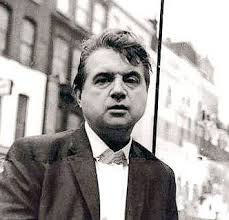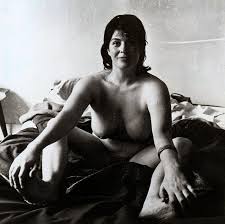Under the Influence: John Deakin, Photography and the Lure of Soho, by Robin Muir, Art Books Publishing, 176 pp (illustrated), £29.99, ISBN: 978-1908970152
Soho in the 1950s was a byword for vice. Its thriving sex industry encompassed “adult” cinemas, brothels, clip-joints, peep-shows, pornography and sex shops, and the police were known to turn a blind eye to certain goings-on in return for a small consideration. It was less famous as the birthplace of British modern jazz, rock ’n’ roll and skiffle music, while Carnaby Street was the fashion centre of Swinging London and Denmark Street the British Tin Pan Alley. Soho also was where that the finishing touches were applied to many of the classics of British cinema. Likewise, it is where London’s Chinatown is located. Former residents of renown include William Blake, William Hazlitt and Karl Marx, and, indeed, the principles of The Communist Manifesto were drafted in the Red Lion pub.


Soho also, in the 1950s and 1960s, was the stamping ground of photographer and sometime painter John Deakin, described by Robin Muir as a “cipher for the luckless, invariably impoverished, Soho ‘character’ of the early postwar years”. Mapping Soho in the introduction to Under the Influence, Muir writes:
The area inside its loosely defined boundaries, within the West End “circuses” of Piccadilly and Oxford, Cambridge and St Giles, as well as the hinterland north of Oxford Street that with its own fluid boundaries had constituted pre- and postwar “Fitzrovia”, was the backdrop for this creative and maverick figure, prodigal and careless with his talent. Both districts promoted a bohemianism that dismantled the barriers of class and nationality and ignored the prevailing sexual mores and strictures of the times.
Famously twice hired and fired by Vogue, Deakin was commissioned to shoot photographs of the celebrities of the day. Other subjects, shot for a Vogue feature on artists, were drawn from his Soho drinking companions. The photographer was not universally popular. George Melly said he was a “vicious little drunk of such inventive malice and implacable bitchiness that it’s surprising he didn’t choke on his own venom”. Woolworth’s heiress Barbara Hutton described him as “the second nastiest man I’ve ever met”. Some acquaintances found it hard to believe there was anyone nastier.
His physical appearance was ridiculed: he was said to have had the “gait of a midget wrestler”, “Mickey Mouse ears” and a pock-marked face “wrinkled like a bloodhound’s”. Striking a somewhat kinder note, poet Cedra Osborne remarked on “a sad comical face and a tongue like a file”. While Francis Bacon found him to be “very amusing”, he added that he needed drink “more than anything else”. A chronic alcoholic, Deakin, like Bacon, was regarded as notoriously difficult. Though the two had a fraught relationship, Bacon held Deakin’s work in high regard.


Born in 1912 on the Wirral peninsula, he was the elder son of John Henry Deakin, a machine minder for Lever Brothers at Port Sunlight, and his wife, Elsie Mary Bond. Educated at Calday Grange grammar school in West Kirby, where he shone at swimming and diving, he was destined to follow his father into employment at Port Sunlight. However, he decided otherwise and at eighteen left the Wirral for Dublin, where he worked at various jobs, including one as a window dresser for a display company; he may also have painted backdrops for theatres.
Taking up art, around 1930 he travelled to Spain to paint the landscape. Returning to England after a few years he settled in London. Later, as companion to Arthur Jeffares, a wealthy American art collector, and later gallerist, he travelled the world and painted. His subsequent exhibition at the Mayor Gallery, London, in 1933 attracted some critical acclaim. A camera left behind after a party in a Paris apartment in 1939 sparked Deakin’s interest in photography. “It was a cheap camera and he’d never taken a picture before,” according to his friend, the poet Elizabeth Smart, “but his tyrannical eyes took over.”
For the next two decades Deakin concentrated on photography, and ceased painting. The fashion illustrator Christian Bérard introduced him to Michel de Brunhoff, editor of French Vogue. However, the Second World War intervened and Deakin was assigned to a British Army film unit. He served in Egypt, Malta and Syria and photographed the second Battle of El Alamein. By the time the war had ended he was an accomplished photographer, and in the immediate postwar years began to establish himself at magazines – Picture Post, Lilliput, Tatler, The Sketch and Harper’s Bazaar.
His most prolific years, and probably his most creative, were spent as a staff photographer for British Vogue in the late 1940s and early 1950s. He was contracted to the magazine by editor Audrey Withers on de Brunhoff’s recommendation, and his sitters for Vogue included Maria Callas, John Huston, Pablo Picasso and Luchino Visconti. He also was obliged to undertake fashion shoots, for which he had little enthusiasm. Withers remained loyal to him despite his habit of losing, possibly pawning, valuable photographic equipment and other misdemeanours. Her patience exhausted, she fired him for a second and final time in 1954. Such was her regard for him, however, that she paid him off handsomely.
Deakin’s forte was portraiture; street photography was another interest. He was in his element, however, shooting portraits of friends, most of whom frequented the pubs and clubs of Soho, the lure of which, eventually, led him away from Vogue. He moved between the French House and The Colony Room (both on Dean Street), from where he was eventually barred. Subjects included the painters Francis Bacon, Lucian Freud, John Minton and the “two Roberts”, Colquhoun and MacBryde, poets WS Graham and Paul Potts and Colony Room proprietor Muriel Belcher, infamous for her combination of high camp and exceptional rudeness.


His photographs made no concession to vanity: after pushing the contrast in his prints to its maximum, every pore and blemish was exposed in intimate close-up. His friend Daniel Farson wrote that he combined “the instant horror of a passport photo with a shock value all his own”, and his portraits were often deemed too unflattering for Vogue to publish. The art critic John Russell compared him to Bacon in his “ability to make a likeness in which truth came wrapped and unpackaged”. His approach, in its obvious lack of “style”, set him apart from his contemporaries and anticipated by at least a decade the stark portraiture of Richard Avedon and Diane Arbus.
Much of Deakin’s work was recovered from the floor of Francis Bacon’s studio as it was being dismantled for shipment to the Hugh Lane Gallery in Dublin in 1998. Dog-eared and splattered with paint, these were portraits of subjects Bacon wished to depict: he commissioned from Deakin photographs of Henrietta Moraes, Isabel Rawsthorne and George Dyer, among others, as aides-mémoires, since he was unwilling to paint from the live model.


Deakin wrote of his approach to photography:
Being fatally drawn to the human race, what I want to do when I photograph it is to make a revelation about it. So my sitters become my victims. But I would like to add that it was only those with a daemon, however small and of whatever kind, whose faces lend themselves to being victimised at all. And the only complaints I have ever had from my victims have been from the bad ones, the vainies, the meanies.
His reluctance to flatter his sitters is obvious in his portrait of poet George Barker, whose high opinion of his looks Deakin did not share. “I stood him up against the biggest lavatory wall in London and shot it. He seemed delighted with it.” Less delighted was Henrietta Moraes, known as “Lady Brett of Soho”, when Deakin photographed her for Bacon. She complained about the invasive and pornographic poses she was asked to adopt, but Deakin insisted that he was following the artist’s instructions to the letter. (Bacon’s Portrait of Henrietta Moraes, based on photographs from the shoot, sold for £21.3 million in 2012.) Moraes never forgot her encounter with the “horrible little man”.


Bacon’s partner George Dyer had genuine cause to complain of Deakin’s portrait of him. A former petty thief, he was kitted out as a successful career criminal for the shoot and stood in front of a window of champagne bottles clearly at a loss to know where to put his hands. There was another side to Deakin, however, which is evident in his pictures of Paris, which were the subject of one of his two exhibitions of photographs. Muir writes that they “presented the city all but devoid of people; but where they appeared, he was particularly sympathetic to those on the margins, the clochards and lamplighters, travelling fairground workers and the stallholders of empty markets”.
Colin McInnes reviewed the exhibition for The Times:
The beauty of these photographs lies in the fund of affection, and at times of pity, that the artist clearly feels for his fellow mortals. [Many of his sitters] are creatures crushed by life, and the artist, quite without condescension or sentimentality, sees the poignancy of their desperate will to live in a world that has quite defeated them.
“These pictures take you by the scruff of the neck and insist that you see,” Elizabeth Smart wrote in the catalogue. “If you have never been to Paris, you will find it haunted when you arrive.”
Deakin returned to painting in the mid-1950s, adopting a naive style that won few admirers. Given the circles in which he moved, much conviction was required to produce any paintings at all, and the critical and commercial failure of these works obviously did little for his morale. He subsequently turned to collage and sculpture.
Although gay, in 1961 Deakin entered into a marriage of convenience with Anna, a stateless Hungarian refugee; in return for citizenship papers she financed a replacement for a mislaid Rolleiflex camera. Like many of his immediate circle, Deakin died before his time, in Brighton in 1972. His naming of Bacon as next of kin obliged the painter to formally identify the body. “It was the last dirty trick he played on me,” Bacon said.
John Deakin did not enjoy a successful career in the conventional sense, and never appreciated the full extent of his wayward talent. He struggled to make a living and was known as a sponger. Daniel Farson commented, “Deakin’s artistic career had one consistency: the moment success came near he veered off in another direction.” His friend and champion Bruce Bernard got to the heart of the matter:
Deakin unfortunately did not care much for what he did best and I’m sure he resented the fact that it was just that. Perhaps never believing in photography’s ultimate refinements gave him his cutting edge.
Robin Muir has done justice to his subject in a stylish and well-produced volume, published to coincide with an exhibition at the Photographers Gallery, London, earlier this year. It contains some outstanding photographs. Anyone with the slightest interest in photography should get their hands on a copy. If you can’t afford the £30 it costs, order it at your local library.
Photographs reproduced above are, from top, of John Deakin, Francis Bacon, Lucian Freud, George Dyer and Henrietta Moraes.
2/11/2014
Paddy Gillan has worked as a journalist and graphic designer.



